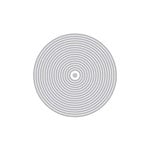 |
| Scroll for the Potted Plants :) |
Masculine Card Set

Eight Thematically Based Cards
Though there are similar characteristics, each card is different from the others. For specific tasks, it was easiest to work with a mass production goal. For example, to make clean-up easier I heat embossed all of the pieces at the same time. This included doing the leafy part, pictured below as a tag on the gift bag.
Ink Techniques
Ink Pad Types
 |
| Gold Pigment Ink Applied to Paper Edges |
More Ink-to-Paper Techniques
Pigment ink is slower to dry. It does not need to be embossed, but a heat tool will speed up the process. I used the gold ink pad to bring some extra depth to the edge of the paper by running the ink pad around each of the sides. Because the overall effect is grungy, it is very forgiving and you do not need to worry about a crisp application. It is ok to mix inks. The picture below shows the same pigment-edged paper after dye ink was applied with an ink blending tool. Notice that ink wasn't deliberately applied in the middle as that part will be covered with patterned paper.
 |
| Ink blending along the perimeter of the page |
Continuing in an assembly-line manner, everything was stamped and embossed or colored and then die-cut as needed. My process is to sort out backgrounds first and then assemble cards based on the elements being used. It helps me to have a big picture so I sometimes will lay out everything to see what components might be missing. The photo below shows this step.
Stamping and Coloring
All of the pots were colored with either woodless colored pencils or alcohol markers. I used either an alcohol blender marker or a paper stump dipped in alcohol to blend the media on the pots. It is easiest for me to color and then die-cut the images. Die cuts allow the various components to be raised above the background or card base. It adds another wonderful layer of dimension and depth to the card. Additional postage may be required for mailing, though.Plants are not always green. And in card making, any color can be used!
Using different sentiments, whether stamped or die cut, allows for many options in card sending.

 |
| Clean and Simple Card |
Recycling A Shopping Bag
Packaging a gift does not need to be fancy. When I was unpacking from a family trip last week, I found this polka-dot bag from a souvenir purchase. Even though the colors are different, it seemed like a great tie-in to the dots on the cards. Brown paper packaging with twine wrapping is one of my favorites for gift-giving. The use of a recycled bag complements the card set. After punching two small holes in it, the embossed tag worked well as a way to hold the twine in place.

















Beverly! What a clever way to use the stamp set. The cards look brilliant, love the texture and details.
ReplyDelete